Tamela Rich's Blog, page 11
January 18, 2014
Wyoming Writing Retreat May 18-24, 2014
Come spend a week with me in beautiful Greybull,Wyoming
I’ll help you meet your writing/content goals
Perhaps you’ve considered a writing retreat or conference to help move your pet project over the finish line or to improve your writing skills.
A retreat is a “retreat from the world” that allows you to focus on your work. Retreats can be self-made (lock yourself in your bedroom or pitch a tent in the back yard) or can be hosted by others, who may or may not provide meals and creature comforts.
A “conference” includes workshops, networking, publisher pitching sessions and so forth. Most conferences are a crush—too many people and too little attention from the faculty. If you are considering a conference, beware the crush factor.
While there are plenty of ways to retreat from the world to write, my experience with writers is that some structured support helps them achieve their goals more quickly and less painfully than the lone-wolf approach. I’ve designed activities for each day of the retreat to help writers sustain momentum. Hop over to this page for the details.
Limited to ten writers. This is about personalized support in an intimate group setting. In my Wyoming Writing Retreat, you’ll be one of ten writers. It doesn’t get any better than that.
Writing a novel, blog series or world domination strategy?
No matter what writing goals you set for yourself, no matter what you’re writing—a business book, memoir, blog series or white paper—I’ll support you in doing your best work. Since this retreat is limited to ten participants, you’ll get plenty of personalized feedback and encouragement.
Want to be a better writer? I know what it takes to write an award-winning book and I’ve designed the curriculum to enhance your writing skills. This page will fill in the details.
Staying in one of my favorite towns, Greybull, Wyoming
We’ll be staying at the Greybull KOA—the perfect atmosphere for productivity. Nestled in the heart of a small town, with wildlife galore and Big Skies overhead, you’ll be inspired to do your best work. Here’s a video preview of the Deluxe Cabin at the Greybull KOA and here’s my Flickr album from the campground.
I’ve stayed at the Greybull KOA three times and know the owners, Dutch-born MaRia and Cor Bijvank, well. They’re delightful hosts and pay attention to every detail. They run their campground like a B&B, and will provide everything we need to stay focused on our work.
The campground is small and we’ll have all six cabins to ourselves. Greybull, itself, is a charming town with fewer than 2,000 citizens. I may know half of them since that’s where my book, Live Full Throttle, was written!
Interested? This page has ALL the details.

January 4, 2014
Your Daily Getaway: Armchair Travel Option for Email Subscribers


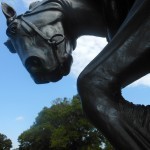
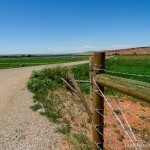
Johnny Cash – I’ve Been Everywhere
Powered by mp3soup.net
Some day I’ll visit all the locales mentioned in the tongue-twisting song, “I’ve Been Everywhere” ( click above to listen to my favorite rendition by Johnny Cash).
I’ve been to a great many of those North American places on my motorcycle, including Fargo, North Dakota, where I ate one of the best Greek meals ever. As a matter of fact, I’ve been to so many beautiful and quirky places that I’ve decided to share them with you in an optional email subscription called the “Daily Getaway.”
Armchair travel option for email subscribers
The Daily Getaway is a picture from my North American travels with a short caption or quote and sometimes a link to learn more about the place or subject. They’re just the right thing to start your day on a positive note. Subscribe right here by checking “Daily Getaway” at the bottom. You can also get an email of each week’s blog posts, if you check that box.
Customize Your Subscription
* indicates required
Email Address *
First Name *
Last Name
State/Province
Zip/Postal Code
Optional Subscriptions
Weekly Blog DigestDaily Getaway
Seriously, folks, don’t rely on social media to dish up everything I have to offer!
Fun factoids
“I’ve Been Everywhere” isn’t just about North American travel. There are versions for Australia, New Zealand, Great Britain and Ireland and a host of others.
And in case you’re reading this post on your mobile device from bed or the potty, you’re not alone!


December 26, 2013
Winter Writing Retreat: Facilitating Author Creativity
This month I facilitated a writer’s retreat for a few mastermind clients who needed a block of time to focus on their books and some intermittent time with me.
It was magical, from start to finish. We stayed at Sacred Grove Retreat Center in Gold Hill, North Carolina, which has everything they needed to fuel their creative processes.
Facilitating author creativity
We began with an intention-setting exercise around the bonfire Thursday night. From that point the authors were on their own to write, eat, sleep, exercise and work with me individually as it suited them.
Since these writers had been working on their books within a mastermind group for nine months, my job in facilitating creativity started with setting the right environment and removing obstacles and distractions. I was probably inspired to go this way by Montessori’s education philosophy of learning within a prepared environment; my boys (now young men) were Montessori-educated for seven years.
It wasn’t my intention or expectation that everyone would eat together—as I said, I promised minimal structure—but by mutual assent we converged for vegetarian dinners I’d catered in. Conversations were soulful and supportive.

Most of us went out for another bonfire Friday night, where the picture at the top of this post was taken—doesn’t it look like an Apple commercial? There’s something about a bonfire that encourages storytelling and intimacy; it was the perfect environment for everyone to read from what they’d been working on and to get thoughtful feedback on their craft and the direction of their books.
We didn’t get around to solving world hunger, but we did address some thorny issues out there with the coyotes! They’re writing books about organizational change, healthcare, health and wellness, and language as a leadership tool. These books-in-progress are already changing my life.
My dear friend, artist-author Catherine Anderson, joined us on Sunday morning to seal our intentions for maintaining creative momentum. Catherine’s a certified labyrinth facilitator, and Sacred Grove’s labyrinth (pictured below) was just outside our door. After walking the labyrinth we made collages to visually inspire us to finish what we’d started—yes, the “we” includes me. I will publish another book in 2014.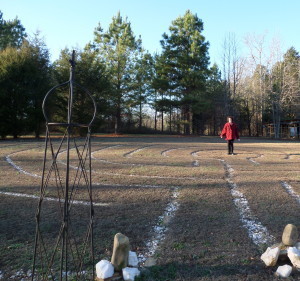
Planning another writing retreat in Wyoming
I loved every moment of the winter retreat and it was a privilege to watch the authors’ projects flourish. When I got home, I was whipped. Whipped, but ready to do it again this spring in WYOMING!
Mark your calendars for May 18-24, 2014. I’ll offer morning workshops and evening group feedback sessions during the week and each writer will get a few hours of individual time with me. Stay tuned for details in the coming weeks.

December 6, 2013
Is Writing a Book One of Your New Year’s Resolutions?
You’ve heard the drumbeat—You need to write a book! Your competitors have already written books, where’s yours? Maybe you don’t need to write a book to succeed, but if you’ve been thinking about it, let’s talk.
What about those claims that you can write a new book every month and make it a bestseller? Um, your mileage may vary.
Some of this book-writing frenzy is generated from people who have a vested interest in selling you services so let’s get real here. The wrong book will do you more harm than good.
I’m here to help you write the right book for the right audience to meet your objectives in my mastermind group for authors that begins January 14, 2014. Working with no more than four other business authors, I’ll lead you through the most difficult parts of writing a book and you’ll emerge with a template for yours. We’ll do the hardest work together, in a supportive environment.
You can do it.
Your book template
Working with five other business professionals, you will finish the course with:
Defined business goals for your book.
An Ideal Reader Profile and set of Reader Objectives.
Key Messages, Themes and a “Voice” for the book.
A “Goldilocks Chapter” of the book, which is a template/sample chapter.
A detailed table of contents with which to begin writing the book by yourself or in collaboration with a professional writer.
A primer on copyright concerns.
Sufficient information to:
Decide whether to seek a publisher or to publish independently.
Choose your book’s format and distribution channel(s).
Begin developing a marketing strategy for your book that could begin before the book is finished.
Hire a team of professionals to help you finish your book.
Mastermind client testimonials
Download the details of the class here. Last year a dozen clients came through the series. Here’s what four of them had to say about the process:
Sheila Kilbane, MD: I participate in one of Tamela’s mastermind groups for authors and business writers. During our sessions I’ve often observed that she knows exactly what to say or what to ask someone in order to inspire them to give their best work. She understands the way her own brain works and she understands very quickly how the brains of those around her work.
Bill Gill of Kinterra Business Group: During my time working with Tamela she molded my thought direction to areas that I had previously not seen. She was able to show me a more narrow and precise way to focus my thoughts and writings that she believed would resonate with a greater audience.
Lynne Ingersoll of Carolinas Healthcare System: Tamela orchestrated a mastermind group and writing workshop that has morphed into a connection that helps me build my writing skills, consider better business decisions and challenge my thinking. All of which, improves my results. Tam helps me put things into perspective and see things from a different lens. She asks questions that stop me in my tracks, especially when I need to stop in my tracks and consider other options. She has a sense of humor and wit that just keeps things rolling in new and unexpected directions. If you haven’t worked with Tamela, try it. She has a positive demeanor that is downright contagious.
Adam Holden-Bache, CEO of Mass Transmit: If you’re looking to write a book and don’t know where to start, Tamela is your answer. Tamela provides a wide range of services to budding authors including a book writing masterclass, manuscript consultant services and providing developmental edits. In short, she can help you take your book concept from idea to a finished product. As an attendee at her masterclass, I learned many valuable insights about self publishing. How to position your book for your target audience, how to prepare your key messages and themes, how to stand out from your competition and how to step through the publishing process are just a few bits of insight Tamela provides.
Okay, you don’t want to be “that guy” trying to sell your book in every conversation, like the one in this cartoon, but at least he has a book! Let’s get started on yours.

November 25, 2013
Announcing a New Keynote Speech and Workshop: Facing Fear
Hundreds of people have asked me about being afraid as I travel by myself. It usually goes something like this: ”Aren’t you afraid some nut job will do you in?”
Answer: I am neither a fearful nor a fearless woman. Sometimes I’ve been frightened and other times I’ve been brave. I’ve also been very lucky.
This repeated line of Q&A called me to develop a new keynote speech and workshop on the topic of fear. The first group to experience this workshop is the Fifth Annual “Luna Rising” at the Unitarian Universalist Church of Charlotte, NC in January, 2014.
Fear as an Energy Source
I’ve learned a lot about facing fears and harnessing their energy for personal growth. On the road, I’ve encountered bad weather and lots of distracted drivers; my wallet and credit cards were stolen in Montana, some 3500 miles from home; I’ve run out of gas; and I’ve had trouble finding a safe place to sleep at night.
Maybe you fear a career or business setback. I’ve experienced both.
Financial ruin? Been there myself.
Afraid your children won’t turn out right? I’ve lived through “the scary phone call from the sheriff,” too.
Whether we meet at a keynote speech or in a workshop, everyone will emerge from the experience with a way to categorize their fears and begin making them a vehicle for positive change.
The Keynote Speech: Facing Fear
Lessons from the Road: Facing Fear, begins with the premise that fear has a role to play in our lives. The question is whether YOUR fears are playing the RIGHT roles. Using what I’ve learned about harnessing the power of fear, I’ll guide participants through a process to help them use fear as an energy source. The keynote is 60 minutes and will be customized for each audience. Here are some ideas:
Groups that are “stuck” are likely harboring a fear of something.
Organizations that are losing members might be afraid to try something new or unorthodox.
Business units that have suffered a setback need to move on, but that’s hard when they’re afraid of failing—again
Facing Fear: The Workshop
This workshop will be interactive and supportive. We need at least three hours to cover everything I’ve planned for you, but we could spend an entire day working through various exercises that would help everyone address a couple of fears with action plans. Here’s the overview:
I’ll guide participants through a process to help them see that fear is an energy source.
Everyone will emerge with a categorized list of their fears and an action plan for channeling the energy of one of them into a powerful outcome.
Arts exercises will help participants remember the resolutions they made during the workshop and practice turning fear into power.
Everyone will have an opportunity to ask for specific support as they venture out on their new journey with fear.
Workshops should run at least three hours. Let’s talk about your needs and timeframe and then I’ll customize yours.
Are you interested in booking this workshop for your group? I‘m booking my 2014 calendar right now, so please get in touch.

November 22, 2013
Gettysburg and My “Mixed” Marriage
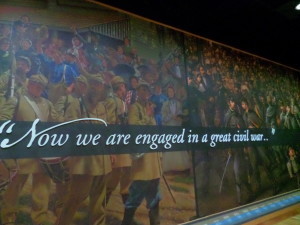
North vs South mural in the Gettysburg Museum
One hundred and fifty years ago this week President Abraham Lincoln delivered the Gettysburg Address. He called upon this country to finish the work envisioned by our founding fathers, bringing forth “a new nation, conceived in liberty and dedicated to the proposition that all men are created equal.”
I visited Gettysburg, Pennsylvania last month with my spouse, while I was in the region to speak at Meritus Healthcare. How ironic that I’d tour Gettysburg—which reminds us that our Union nearly dissolved—on a day that our government was closed on purely partisan grounds. I’m sure Lincoln would have expected to see more progress in our Union since his assassination.
The cold, drizzling rain added to the somber mood as we visited the incredible Gettysburg National Military Park Museum and Visitor Center, which was open during the shutdown because it’s run by a private foundation instead of a federal agency. We spent half the day there and still didn’t see everything it had to offer. Scroll down for a video of what awaits visitors.
My Union-Confederacy Marriage
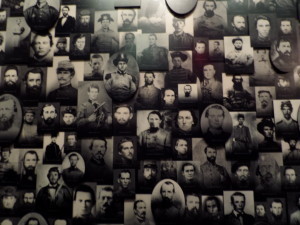
Mural in the museum, “Faces of Gettysburg”
I grew up in Ohio, about 20 miles from the hometown of , and about 30 miles from the birthplace of General Sherman, both of whom were Civil War heroes. To tell the truth I only knew about these generals because various public schools were named in their honor, not because I studied their war resumes.
My Ohio history lessons of the war were superficial and began and ended with the understanding that the war was fought on moral grounds and we won. Full stop. Ancient history. Move on.
Until I married a man who was raised in Richmond, Virginia, a capital of the Confederacy.
Matt studied Civil War history for weeks on end throughout his public school education. They called it ”The War of Northern Aggression” in his classrooms, and taught that the Civil War wasn’t really about slavery, rather, it was about states’ rights and economics. He knows so much about the Civil War that he can even tell you the names of the generals’ horses.When we went to see Daniel Day Lewis in Lincoln last year, I had to ask Matt to tell me what was going on several times.
The war wasn’t just lore to him, it was family history. His great-grandfather was captured at Gettysburg and eventually released to find his way back to his North Carolina home. What a journey that must have been.
I’ve visited several towns this year with Civil War history but the subject has always been remote. The war became personal to me in the exhibit hall of the Gettysburg National Military Park Museum.Comparing the uniforms and kits of the Union and Confederate soldiers, I was struck by how poorly outfitted Johnny Rebel was. They never stood a chance, and I married one of their descendants. The Confederates had some strange ideas and were fueled by false hopes and hubris, but at that moment, I recognized them as family. Truth is, they’ve always been family, even before I married a Virginian.We’re all one human family.
The exhibits were so masterfully executed and our battleground tour guide so passionate that we found ourselves emotionally drained by the experience. Thousands dead. Families ripped into blue and gray factions. Amputees and orphans everywhere. When Lincoln spoke at Gettysburg, nearly six months after the battle, some of the dead still hadn’t been buried.
Going back to the hotel, Matt asked me what I wanted to do next and I said, “Let’s turn on HBO and see if we can find a comedy. I need a laugh.” What was playing when we got there? Wait for it…Abraham Lincoln, Vampire Hunter. I kid you not.
Recommendations for Gettysburg National Military Park Museum and Visitor Center
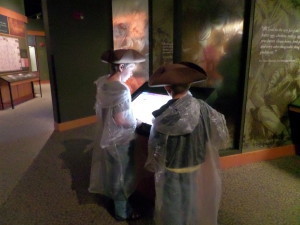
Look at these little kids interacting with the displays!
The first time I visited Gettysburg I was a disinterested teenager on a family vacation. The uninspiring glass and acrylic case displays of war detritus like musket balls, cannon shrapnel and rusty horse shoes bored me. The new visitor’s center opened in 2008. and Epcot, you’ve got nothing on this place!
Look at these cute kids (left) in their rain gear learning how miserable a foot soldier must have been in the rain.
This official video will tell you what you’d like to know about visiting.
Click here to view the embedded video.
We bought the full pass that included the cyclorama, museum and a battlefield tour. If you buy all three and like me, you love to immerse yourself in experiences, be sure you start your day early and plan to spend a good five hours in the museum’s eleven halls. The balancing act will be allocating your time between the museum and tour; the cyclorama doesn’t take time from the other two and you won’t want to miss it.
And to save you searching elsewhere, here’s the full 272 words of the Gettysburg Address:
Fourscore and seven years ago our fathers brought forth on this continent a new nation, conceived in liberty and dedicated to the proposition that all men are created equal. Now we are engaged in a great civil war, testing whether that nation or any nation so conceived and so dedicated can long endure. We are met on a great battlefield of that war. We have come to dedicate a portion of that field as a final resting-place for those who here gave their lives that that nation might live. It is altogether fitting and proper that we should do this.
But in a larger sense, we cannot dedicate, we cannot consecrate, we cannot hallow this ground. The brave men, living and dead who struggled here have consecrated it far above our poor power to add or detract. The world will little note nor long remember what we say here, but it can never forget what they did here. It is for us the living rather to be dedicated here to the unfinished work which they who fought here have thus far so nobly advanced. It is rather for us to be here dedicated to the great task remaining before us—that from these honored dead we take increased devotion to that cause for which they gave the last full measure of devotion—that we here highly resolve that these dead shall not have died in vain, that this nation under God shall have a new birth of freedom, and that government of the people, by the people, for the people shall not perish from the earth.

October 1, 2013
Touring West Virginia and Speaking in Hagerstown, Maryland
Confession: I felt shortchanged this summer when the bearings went out in my motorcycle’s engine and I had to rent a car to get to Billings, Montana for a week of engagements.
Note to self, that’s a serious sense of entitlement, Tamela.
This Friday I leave for a week on my bike. My ultimate destination is Hagerstown, Maryland (details below). I have a pent-up need for twisty roads and nature, which I’ll get a lot of as I travel through West Virginia and western Maryland.
If you live anywhere nearby, please get in touch. I’d love to grab a cuppa.
MSTA Fall Colors Rally
I’m eager meet up with my dear friend Jill, a fellow BMW GS rider and knitter, in West Virginia at the Motorcycle Sport Touring Association’s Fall Colors Rally near The Greenbrier and we’ll tour some fabulous roads in the Monogahela National Forest. The leaves will be turning before our eyes, so I already have a fresh SD card in my camera!
If you’ve never been in the region, this topo map will give you a sense for the wonders that await us. Let me know if you’ll be in the area over the weekend, okay?
Hagerstown Rotary Club
I think our media-drenched lives perpetuate a world view that people are scary (at best) and evil (at worse) and that’s simply not true. I’ll address that Wednesday, October 9 with the Rotarians when they meet at the Fountain Head Country Club at noon.
The number one question I’m asked about my travels is whether I’m afraid to travel alone. I’ll talk about life on the road as a solo traveler, telling stories of people who’ve helped me out of jams and inspired me to live a better life.
Meritus Health’s Pink Palooza
When I spoke to the National Consortium of Breast Centers this March, the organizers of Meritus Health’s Pink Palooza asked me to speak to breast cancer survivors and their families. On Friday, October 11 at 6:00 p.m.
I look forward to sharing stories from folks I’ve met who’ve faced the disease with grace, humor, moxie and joy; they certainly changed my outlook on life. While there I’ll also be signing copies of my book, Live Full Throttle: Life Lessons from Friends Who Faced Cancer. This video gives you a sense for what’s in store at Meritus.
Click here to view the embedded video.

Meet 83-year-old Sally Stanke, a Woman (still) on Wheels
If you think you’re too young or too old to do what calls to you in life, you’re going to love Sally Stanke, who celebrated her 83rd birthday last month.
Finishing school? Nah, I think I’ll fly an airplane!
Sally’s parents thought they were sending her off to finishing school at Stephens College in Columbia, Missouri but Sally found an avocation as an airplane pilot and studied aviation instead of etiquette. “They never finished me,” she laughs. Sally qualified for her pilot’s license in 1946, at the tender age of 16 and followed up with a commercial license three years later.
As testament to the power of passion, she paid for her aviation lessons driving a tractor for wages of 50 cents an hour. I think of her when I hear people complaining that they can’t do what they want to do because they don’t have money or a college education or the right contacts, etc., etc. Holy, cow, Sally did all kinds of things that women weren’t supposed to be able to do in the late 1940′s including riding a motorcycle. By herself. Across the country.
 She taught herself to ride a motorcycle by traveling on a Harley-Davidson 125 from Missouri to Florida. What a sight she must’ve been in 1949 pulling into a service station and mixing oil with gas for her two-stroke engine!
She taught herself to ride a motorcycle by traveling on a Harley-Davidson 125 from Missouri to Florida. What a sight she must’ve been in 1949 pulling into a service station and mixing oil with gas for her two-stroke engine!
All in, Sally’s been riding motorcycles for 64 years, right up to this summer when she rode her Honda trike to Billings (for the Women on Wheels International Ride In) from her home in Bozeman, Montana. She only went to three wheels five years ago.
Unlicensed kids on Chief Joseph Highway
In the podcast, you’ll hear her tell me a story about riding motorcycles with her three children on the Chief Joseph Highway (a favorite road of mine in Wyoming). What a fun mom she must’ve been. I’d love to be a fly on the wall at that family’s next gathering! The rode wasn’t paved back then, and none of the kids had motorcycle licenses at ages 15, 12 and 10, but that’s why they were on the Chief Joseph anyway. In Sally’s words, “No one was checking rides.”
This quip reminded me of that classic line from The Treasure of the Sierra Madre when Humphrey Bogart questions the credentials of some tough hombres, “Badges, I don’t have to show you any stinkin’ badges.”
Click here to view the embedded video.
I was more impressed by Sally than I think she has ever been of herself. She has that just-doing-what-needs-to-be-done quality that I’ve observed in many Western women. What’s in the water out there, anyway?
I met several pioneering women in the motorcycling world while out in Billings, Montana this summer with the Women on Wheels’ annual Ride-In and I’ll introduce you to more in the future. Sally was awarded a 30-year membership pin at the Ride-In.
I hope you’ll click the podcast link above and listen to my interview with Sally. Of course you can subscribe to the podcast on iTunes and Stitcher. If you do, please write a nice review of the series.

September 18, 2013
Developing a Great Presentation: Lessons from Pecha Kucha
Right before Labor Day weekend I delivered my first Pecha Kucha, “Alone in the Tetons After Dark.” The constraints of the Pecha Kucha format taught me a few things that could help anyone developing ANY kind of presentation. Read on!
What’s Pecha Kucha?
Pecha Kucha is a Japanese phrase that basically translates to “chit chat”.
Pecha Kucha speakers and performers follow a prescriptive format: they must devise 20 slides/images which will be shown to the audience on a big screen for 20 seconds each. The slides are on a timer, so speakers who stumble or skip their lines have to find a way to keep up with what the audience sees.
This format means speakers must get their point across in six minutes and 40 seconds.
Presenters can give a talk, recite poetry, dance, or most anything they want with the form, so long as they do so with 20 slides. Pecha Kucha events are now a worldwide phenomenon.
Preparing for a Pecha Kucha
Draft your remarks in a spreadsheet
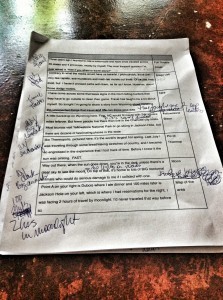 On the first draft of my presentation, I set up a table with two columns from left to right: 1) the script and 2) the name of each slide.
On the first draft of my presentation, I set up a table with two columns from left to right: 1) the script and 2) the name of each slide.
As I started weaning myself from the script, I added the The “key point” column (handwritten in this picture on the far left). I used it to be sure I was hitting the points without reading the script. No one wants to be read to!
The final table had 20 rows (one for each slide) and 3 columns: 1) key points 2) script and 3) slide name. Starting over, I would begin developing a presentation with those three columns.
This website converts words to minutes beautifully. I began writing with no more than 50 words per slide. As I rehearsed and added storytelling techniques like gestures and pauses and allowed for audience interaction, I eventually averaged about 40 words per slide. I suggest you start with your remarks, then add your images to fit, instead of the other way around.
Record your remarks on the slides
I went into the settings of Keynote (Apple’s equivalent to PowerPoint) and set the slides to change automatically at the requisite 20-second interval. Then I used my script to record my remarks into the presentation and played it back to see how it sounded and whether the pacing worked. At first, the slides raced ahead of my script.
From there it was an iterative process. I trimmed the script and moved words from one slide to another and substituted images that better supported the modified script. Each time I made a change, I recorded the presentation and played it back. Eventually the words and slides came together within the 20-second screen timeframe.
Next, I played the presentation in the background while I was doing other things, with the goal of learning it in the way that we subconsciously learn song lyrics when we’re driving around listening to music.
Full-size your images
Pecha Kucha emphasizes the visual experience for the audience. There is a whole wing of the design profession dedicated to images and slides so I won’t attempt to cross that Rubicon in this post.
The event organizers reviewed all of our decks, and I got some great feedback on how to improve mine, starting with sizing the images to fill the screen. Completely. Obviously this isn’t a steadfast rule for all types of presentations or even for all slides in the deck, but next time you have a slide with only one image, try up-sizing it.
It bears repeating to avoid words and bullets whenever possible, or to minimize their use when you must. I didn’t have a single word on my Pecha Kucha slides.
Use big gestures
Next, I paid a visit to my friend Lou Soloman, a communications consultant. I like rehearsing at her studio, where she and her team use video to point out opportunities to use auditorium-sized gestures and to pause so the audience can absorb an important statement.
Lou has coached me on using big gestures before, and I’m working my way into that comfort zone. The video she takes shows me that I really don’t look stupid when I “go big,” even though it’s not yet a natural inclination. I’m reminded of interviews with actors who also remark about the need to over-gesture when they’re on stage as compared to a film studio where the cameras zoom in. Watching my before- and after-coaching videos I knew I was on my way, big gestures and all. At that point, it was a matter of practice.
Rehearse without slides
Once I thought I had my material down pat, I tried an experiment: I fired up my voice recorder and ran through the presentation without slides. Then, I played the recording back with the timed slides to see whether I had internalized the timing (I pretty much had). This served me well because when I got to the venue, I didn’t have a screen of my slides facing me…and I was prepared to stand and deliver without looking over my shoulder all the time to verify I was concurrent with the screen.
I probably rehearsed this talk for five hours, including the iterative drafts, the sessions with Lou, and the five or six times in the wings right before I went on stage. I took the stage without notes, enjoyed myself tremendously and actually finished a bit ahead of the slides…a miracle for this wind bag!
Five takeaways from my Pecha Kucha experience
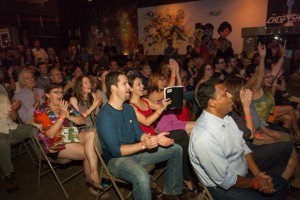
photo courtesy of mitchellkearney.com
Presenting a Pecha Kucha took my speaking professionalism up a notch, beginning with learning to measure time in twenty-second intervals. The constraint forced me to pay attention to every SINGLE word and taught me how to wring every opportunity out of every one of them.
I believe these five tips will help you develop a Pecha Kucha or another kind of presentation:
Use the three-column table to draft and organize your remarks and slides. Left to right, the columns are key messages, script, and slide name. If you’re giving a talk without slides, make it a two-column table (key messages and the script) instead of writing it out in paragraphs.
Record your remarks in your slides, then play them back. You will instantly (and consistently) find opportunities to prune and focus, no matter how many times you do this.
Play the recorded presentation over and over again to help yourself memorize it. Put it on a play loop if you have the technology to do so, and let it run like the radio in the background of your life.
Record yourself delivering the talk without slides to see how well your timing holds to the slides and to aid memorization. If you forgot to say something, ask yourself if that’s your subconscious mind telling you the point is irrelevant.
Change your slides frequently. Twenty seconds might not be an appropriate interval for your presentation, but lingering on a slide for several minutes is BORING —unless you are telling a spellbinding tale or doing something besides speaking, which most people don’t.
Do you have an important presentation on your horizon? I’m here for you.

September 17, 2013
My New Book: “Retirement GPS” with Aaron Katsman
 This time last year I started writing Retirement GPS: How to Navigate Your Way to Way to a Secure Financial Future with International Investing with expert Aaron Katsman. The book was released a couple of weeks ago, on August 23.
This time last year I started writing Retirement GPS: How to Navigate Your Way to Way to a Secure Financial Future with International Investing with expert Aaron Katsman. The book was released a couple of weeks ago, on August 23.
I provided manuscript development and editing services to Aaron on this project, beginning with the Goldilocks Chapter that secured his book contract with McGraw-Hill.
Write your book with your unique voice
Aaron is blessed a strong voice that I knew would help the book resonate with his intended audience: investors in middle age and older. His personality shines throughout the book, especially in the humorous, self-deprecating anecdotes. Here’s one at the top of a chapter about whether to work with professional financial advisors:
Before I was married and my wife could steer me in the right direction, I got pretty sick but didn’t know what was wrong with me. I had a fever over 101 degrees (Fahrenheit) for five days in a row, had little appetite and, in manly fashion, figured I would take some Tylenol and a few bowls of chicken soup and all would be well. After a week, a friend came over to visit and told me that I looked a bit yellow. I finally decided to pay a visit to the doctor, who quickly diagnosed me with hepatitis!
“Oops” I said, “I guess I got that diagnosis wrong.” What made things even worse was that I was living with a few roommates and they all needed to get shots. One had just left on vacation abroad, so it took a while to track him down to tell him to get his immune globulin shot. Needless to say I wasn’t the most popular guy in the apartment!
Had I put my ego to the side and relied on a professional, I would have saved myself and my friends a lot of pain and inconvenience.
Does the same hold true for an investors retirement portfolio? Is a retiree who manages his own money a fool, or an investor who saves a lot of money over the long-term and achieves her stated goals?
Working with me as a book editor
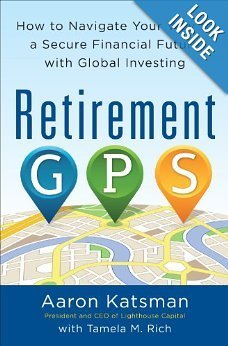
I provided manuscript development and editing services to author Aaron Katsman.
I knew from developing that Goldilocks Chapter that the book should resonate with Aaron’s unique wit and verve. His book proposal contained a table of contents that became the backbone of our work, but the anecdotes and interviews with industry experts really make the book sing.
You might think you don’t have a unique voice or other “special sauce” to use in your book, but you do, and I’ll help you discover it. My experience as a ghostwriter comes into play even when I’m not ghostwriting.
Reviewers consistently note how easily the book reads and how the conversational tone makes Aaron’s financial advice accessible to people who don’t usually read investment books. Here’s one such review:
I thought that Aaron and Tamela did a fabulous job in writing about Investing Internationally or Globally. They made it understandable for the average person and shared poignant stories as well as interviews with industry leaders. I heartily recommend this book.~Joshua M. Normand
As the reader’s advocate, I watched for places where one of Aaron’s stories or case studies was needed, and he had several to choose from every time. We also made liberal use of case studies to help readers find themselves in Aaron’s advice and research. This did not go un-noticed:
…folksy wisdom laced with entertaining stories, combined with a broad knowledge of world economies and their myriad financial products…paint a clear picture of how one can skillfully diversify his investments beyond the United States into what Mr. Katsman calls the GPS portfolio.” ~Navad Serling (in the book’s Foreword)
About Retirement GPS
In Retirement GPS, Aaron calls for a more balanced portfolio in light of today’s realities–one that places heavy emphasis on foreign investments. This no-nonsense guide teaches you:
Why international investing is critical to your retirement portfolio
Where the best places to begin investing are–from Scandinavia to the Middle East
How to invest in foreign stocks and bonds
Here’s what Aaron said of my work:
It was a pleasure working with Tamela on my book. She knows business and finance well, so I didn’t have to waste time bringing her up to speed AND she definitely provided value by making suggestions that helped strengthen my manuscript. Even though we were working on our project internationally—very different time zones—it was easy to work with her. As an accomplished writer/ghostwriter- she did a great job of helping capture my voice in my material.~Aaron Katsman, President and CEO of Lighthouse Capital, Ltd.
If you’ve been sitting on a book idea, let’s talk. The first consultation is on the house for qualified prospective authors.




